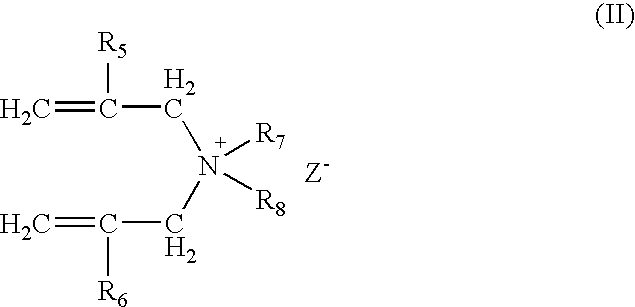Composition and method of preparing high solid emulsions
a technology of solid emulsion and composition, applied in the field of composition and method of preparing high solid emulsion, can solve the problems of not being able to disclose compositions, and achieve the effect of reducing the number of compositions
- Summary
- Abstract
- Description
- Claims
- Application Information
AI Technical Summary
Benefits of technology
Problems solved by technology
Method used
Image
Examples
example 1a
Comparative
[0145] A conventional inverse emulsion comprising 40% is prepared using standard means of polymerization. The copolymer component of the emulsion contains 80% dimethylaminoethyl acrylate quaternized with methyl chloride (DMAEA.MeCl) and 20% acrylamide thus making the copolymer 80% cationic in nature. The standard means of inverse emulsion polymerization involves preparation of the aqueous phase, preparation of the oil phase containing 2.3% emulsifying surfactant, and homogenization of the two for one hour by use of a Silverson mechanical homogenizer to form the emulsion. Primary constituents of the oil phase and aqueous phase are outlined below.
Aqueous Phase:Acrylamide @ 50.0%160.0gDimethylaminoethyl Acrylate @ 80.0%400.0gWater105.5gOil Phase:Naphthenic / Paraffenic oil270.0gSorbitan Monooleate (surfactant)23.0g
[0146] Upon homogenization, the particle size of the resulting emulsion is measured before polymerization by use of a HORIBA LA-910 particle size analyzer. The ho...
example 1b
Comparative
[0147] A conventional inverse emulsion comprising 30% copolymer by weight was prepared using standard means of polymerization. The copolymer component of the emulsion contains 40% sodium acrylate and 60% acrylamide thus making the copolymer 40% anionic in nature. The standard means of inverse emulsion polymerization involves preparation of the aqueous, preparation of the oil phase containing 2% emulsifying surfactant, and homogenization of the two for one hour by use of a Silverson mechanical homogenizer to form the emulsion. Primary constituents of the oil phase and aqueous phase are outlined below.
Aqueous Phase:Acrylic Acid @ 100.0%120.0gAcrylamide @ 50.0%360.0gCaustic Soda75.0gWater97.0gOil Phase:Naphthenic / Paraffenic oil300.0gSorbitan Monooleate (surfactant)20.0g
[0148] Upon homogenization, particle size of the resulting emulsion is measured before polymerization by use of a HORIBA LA-910 particle size analyzer. The homogenization and particle size determination pro...
example 2a
Comparative
[0150] A conventional microemulsion comprising 28% copolymer by weight is prepared using standard means of microemulsion polymerization. The copolymer component of the emulsion contains 40% ammonium acrylate and 60% acrylamide thus making the copolymer 40% anionic in nature. The standard means of microemulsion polymerization involves preparation of the aqueous phase, preparation of the oil phase which contains 7.1% of an emulsifying surfactant blend with an HLB value of 9.1, and the mixing of the two phases together to allow the surfactants present to form the emulsion. No mechanical homogenization was employed. Primary constituents of the oil phase and aqueous phase are outlined below.
Aqueous Phase:Acrylic Acid @ 100.0%112.0gAcrylamide @ 50.0%336.0gAmmonium Hydroxide85.0gWater74.0gOil Phase:Naphthenic / Paraffenic oil300.0gSorbitan Sesquioleate (HLB value 3.7)12.0gPolyoxyethylene Sorbitol Hexoleate59.0g(HLB value 10.2)
[0151] Degassing of the resulting emulsion is accomp...
PUM
| Property | Measurement | Unit |
|---|---|---|
| temperature | aaaaa | aaaaa |
| temperature | aaaaa | aaaaa |
| mean diameter | aaaaa | aaaaa |
Abstract
Description
Claims
Application Information
 Login to View More
Login to View More - Generate Ideas
- Intellectual Property
- Life Sciences
- Materials
- Tech Scout
- Unparalleled Data Quality
- Higher Quality Content
- 60% Fewer Hallucinations
Browse by: Latest US Patents, China's latest patents, Technical Efficacy Thesaurus, Application Domain, Technology Topic, Popular Technical Reports.
© 2025 PatSnap. All rights reserved.Legal|Privacy policy|Modern Slavery Act Transparency Statement|Sitemap|About US| Contact US: help@patsnap.com



